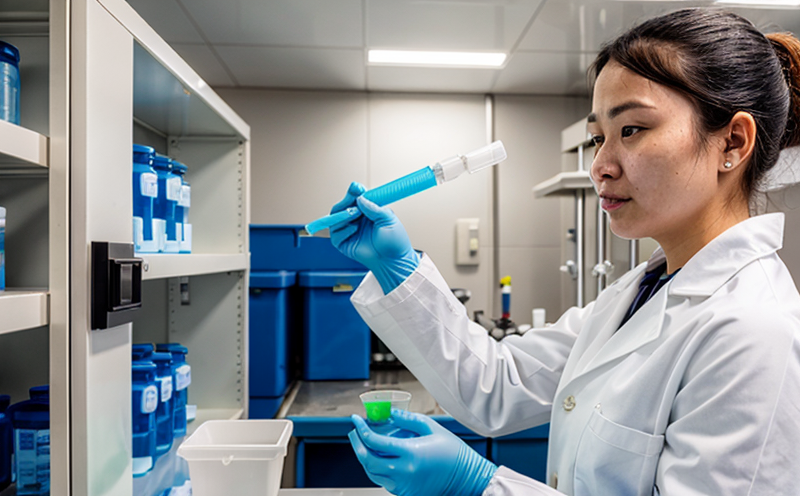USP Antimicrobial Effectiveness Testing
The United States Pharmacopeia (USP) Antimicrobial Effectiveness Testing is a critical procedure that ensures pharmaceutical products are safe and effective. This testing evaluates the antimicrobial efficacy of various formulations, ensuring they meet stringent USP standards for microbial contamination control.
Pharmaceutical manufacturers must adhere to rigorous guidelines set by regulatory bodies like the FDA to ensure their products are safe for consumption or use. The Antimicrobial Effectiveness Testing is one such measure that guarantees that medications do not harbor harmful microorganisms, which could lead to infections or other adverse effects.
The testing process involves several stages, including selecting appropriate test organisms, preparing the samples, inoculating them with these organisms, and then incubating under controlled conditions. The effectiveness of the antimicrobial agent is determined by its ability to inhibit or kill the introduced microorganisms within a specified time frame.
Accurate testing requires precise control over environmental factors such as temperature, humidity, and pH levels. This ensures that any observed changes are due to the antimicrobial properties themselves rather than external influences. The USP guidelines provide detailed instructions on how these parameters should be maintained during testing.
The results of this test play a crucial role in ensuring product quality and compliance with regulatory requirements. For instance, if the antimicrobial agent fails to meet the required standards, it may indicate manufacturing issues or potential contamination risks that need addressing before release into the market.
Understanding why USP Antimicrobial Effectiveness Testing matters is essential for those involved in pharmaceutical development and production. By adhering to these stringent tests, manufacturers can maintain high standards of hygiene and safety across their entire product range.
Why It Matters
The importance of USP Antimicrobial Effectiveness Testing cannot be overstated when it comes to safeguarding public health. Contamination with harmful microorganisms can lead to severe illnesses or even fatalities if not properly addressed during the manufacturing process.
Incorporating this testing into your quality control measures helps protect consumers from potentially dangerous products while also enhancing brand reputation through demonstrated commitment to safety and efficacy.
By ensuring that every batch of pharmaceuticals undergoes rigorous testing, you're contributing significantly towards reducing preventable diseases caused by antibiotic-resistant bacteria or other pathogens. This proactive approach not only benefits individual patients but also contributes positively to global public health initiatives aimed at combating antimicrobial resistance.
Moreover, compliance with these tests is often a requirement stipulated within international standards such as ISO 17895:2013 and USP . Adhering to these guidelines demonstrates your company’s dedication not only to meeting industry expectations but also to promoting best practices in biopharmaceutical research and development.
Benefits
Implementing USP Antimicrobial Effectiveness Testing offers numerous advantages for pharmaceutical companies, including:
- Enhanced Product Safety: Ensuring that all batches comply with stringent microbial limits helps prevent contamination and potential health hazards.
- Regulatory Compliance: Meeting these tests allows firms to meet regulatory requirements set forth by organizations like the FDA and EMA, thereby avoiding costly penalties or product recalls.
- Improved Reputation: Demonstrating a commitment to quality through thorough testing can boost your brand’s image among consumers who prioritize safety above all else.
- Reduced Risk of Contamination: Regularly performing these tests reduces the likelihood of introducing harmful microorganisms into formulations, protecting both employees and end-users alike.
In summary, incorporating USP Antimicrobial Effectiveness Testing into your quality assurance protocols is a wise investment that pays dividends in terms of public trust and regulatory satisfaction.
Use Cases and Application Examples
The application of USP Antimicrobial Effectiveness Testing spans various areas within the pharmaceutical industry, including:
- Cosmetics: Ensuring that cosmetic products are free from harmful microorganisms is crucial given their direct contact with skin.
- Vaccines: For vaccines, it’s vital to confirm that the active ingredients remain potent despite potential microbial contamination throughout storage and administration.
- Biopharmaceuticals: The testing ensures that biologic medicines maintain their integrity even after exposure to various environmental conditions during transport or use.
An example of how this test is applied can be seen in the development of an antibacterial cream. During production, samples would be taken and tested according to USP guidelines. If successful, these creams could then be marketed as effective against targeted bacterial strains without fear of causing infections due to poor manufacturing practices.
Another instance involves biodegradable sutures used during surgeries. Prior to release, they undergo antimicrobial effectiveness testing to ensure that they do not harbor any pathogens which might compromise healing processes post-operation.





